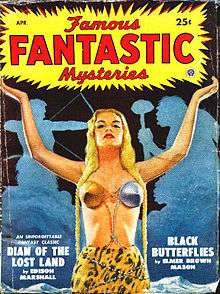Elmer Brown Mason

Elmer Brown Mason (1877–1955) was an American writer. He studied at Yale for a period, but then transferred to Princeton, from which he graduated in 1903.[1][2] Mason became an entomologist for the now-defunct Bureau of Entomology (USDA) in 1910. In addition, he was a seasoned world traveler. In 1915, his fantastic stories of scientists hunting rare species in the remote corners of the world started appearing. Of note were the five stories featuring swamp-guide, Wandering Smith, in The Popular Magazine, especially "The Golden Anaconda";[3] and the variety of tales in All-Story Weekly, highlighted by the horror-filled lost-race novelette "Black Butterflies," set in Borneo, and its sequel, "Red Tree-Frogs."
Mason was gassed in France during World War I, suffering permanent disabilities, which sidetracked his writing career.[4] His globe-trotting ceased and his stories exchanged the fantastic for the domestic. His fiction writing career petered out around 1926.[5]
He had a brief revival in 1949-50 in the pulp magazines, Famous Fantastic Mysteries and Fantastic Novels, which reprinted four of his stories from All-Story Weekly.
"Black Butterflies," was included in the anthology Rainbow Fantasia: 35 Spectrumatic Tales of Wonder ed. by Forrest J. Ackerman; Anne Hardin.[6]
References
- ↑ "Class of 1903, Yale College"
- ↑ http://www.worldcat.org/oclc/59360565&referer=brief_results
- ↑ "Street & Smith's Forgotten Pulp: The Popular Magazine," by Ed Hulse, Blood 'n' Thunder #24 (Summer 2009).
- ↑ Letter to The Camp-Fire, Adventure magazine, November 30, 1925.
- ↑ The most complete biography is to be found in the introduction to The Golden Anaconda: and Other Strange Tales of Adventure, by Elmer Brown Mason (Off-Trail Publications, 2008).
- ↑ http://www.worldcat.org/oclc/49733655&referer=brief_results